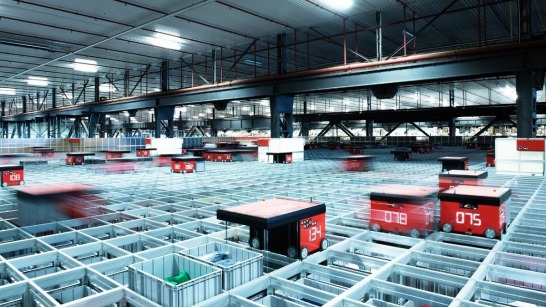
A compact package
A warehouse without aisles. The AutoStore® solution is turning warehousing on its head – access is from above. Dematic has now added this system to its portfolio of products.
2018-06-04
A warehouse without aisles. The AutoStore® solution is turning warehousing on its head – access is from above. Dematic has now added this system to its portfolio of products.
2018-06-04
Retailers call it the ‘curse of the endless shelf’ – customers are used to getting everything they want at any time. But how do you store ‘everything’ in a single warehouse, or at least as much as possible? Storing the goods, boxes, and containers together as closely as possible is one solution. That solves the space problem, but how do you access the items efficiently and make them available quickly for order picking?
Dematic has found an interesting answer to that question in the AutoStore warehousing and order picking system, which stores articles in a grid of rectangular containers like building blocks, creating a compact aluminum construction. No aisles are needed, as articles are accessed from above by robots that move along the grid. “This results in highly efficient density,” says James Stollberg, Executive Vice President Global Product & Solution Management at Dematic. “The system allows up to four times more stock to be stored on the same footprint, and the modular system means it can be used in any warehouse, regardless of shape or size.” An agreement with AutoStore enables Dematic to sell the technology to its customers, and to configure and install it for them, as part of its own portfolio.
Dematic's AutoStore warehousing and order picking system.
The most in-demand items stay on top
“We’re a solutions provider,” Stollberg points out. “We want to deliver the best solution based on the customer’s needs, whether that be with technologies that we’ve developed ourselves, or with a system like AutoStore.” As well as being impressed by the way in which items are stored, Dematic also regards the algorithm used to sort containers as particularly promising. Items that are frequently required are stored at the top and can be quickly picked up by the robots. Items that are less in demand are stored at the lower levels – retrieving these takes longer as the containers on top need to be removed first and then put back.
Michael Khodl, Vice President Global Solutions Management at Dematic, explains: “Imagine an automotive supplier, for example, that has the latest headlights in stock, and these are requested in large volumes. But the supplier also stocks headlights for a 1982 model, just in case a customer expects to receive them the next day.” The AutoStore algorithm stores these at the bottom of the pile, but if headlights from the 1980s should suddenly become popular again, they will be stored further up. “The algorithm is highly complex, and it’s constantly learning,” Khodl says. This results in a system that works at a reliable speed overall. Items stored at the top are available within a few seconds and those at the bottom within a few minutes. On average, a robot can handle around 25 containers an hour, and the number of robots can be increased or reduced as required. “Our Dematic Multishuttle works along similar lines,” Stollberg says. “Products that are in low demand are stored further toward the back.”
Countless variations
“We’ve seen a growing number of retailers and manufacturers across many sectors rethink the structures and processes in their warehouses,” Khodl says. Many companies also face the challenge of having to extend their existing warehousing, while the trend for smaller intermediate depots has led to more new warehouses being built.
The advantage for Dematic customers is that they can pick and choose from, or even combine, existing solutions according to their specific requirements. AutoStore is based on standardized systems that can easily be combined with those used by Dematic. “We can now offer customers a slim-line solution, such as a combination of AutoStore and our Dematic iQ management software. But we can also plan an entirely new warehouse that incorporates a whole range of different elements.” For example, AutoStore’s tightly packed grid combined with rack storage systems where KION Group trucks handle the pallets.
A further advantage of AutoStore is that the system is easily scalable, so it can grow with the warehouse, if required. And thanks to its unique modular design, it fits a crooked old building as easily as a new build on a greenfield site. “The variations of what customers need and want are endless,” says Stollberg. “Our ambition is to provide a solution for them all. We’re not trying to sell one specific technology as the only one suitable.”